Abstract
Prof. E. A. Owen and R. W. Williams1 have recently advanced a theory in which they account for the Widmanstätten figures in meteorites on the basis of their X-ray studies of iron-nickel alloys, natural and artificial. Their conclusions have been criticized by Prof. S. W. J. Smith and J. Young2 on the grounds that only the surface of the meteorites is heated by passage through the earth's atmosphere. This criticism must not be allowed to detract from the merits of the experimental evidence given by-Owen and Williams, which to a large extent receives confirmation from an investigation I have recently carried out with Mr. Goldschmidt.
This is a preview of subscription content, access via your institution
Access options
Subscribe to this journal
Receive 51 print issues and online access
$199.00 per year
only $3.90 per issue
Buy this article
- Purchase on Springer Link
- Instant access to full article PDF
Prices may be subject to local taxes which are calculated during checkout
Similar content being viewed by others
References
NATURE, 142, 999 (1938).
NATURE, 142, 1162 (1938).
NATURE, 143, 384 (1939).
Author information
Authors and Affiliations
Rights and permissions
About this article
Cite this article
BRADLEY, A. Structure of Meteorites. Nature 143, 518–519 (1939). https://doi.org/10.1038/143518a0
Issue Date:
DOI: https://doi.org/10.1038/143518a0
Comments
By submitting a comment you agree to abide by our Terms and Community Guidelines. If you find something abusive or that does not comply with our terms or guidelines please flag it as inappropriate.



